
Aldeburgh is a coastal town in the county of Suffolk, England, north of the River Alde. Its estimated population was 2,276 in 2019. It was home to the composer Benjamin Britten and remains the centre of the international Aldeburgh Festival of arts at nearby Snape Maltings, which was founded by Britten in 1948. It also hosts an annual poetry festival and several food festivals and other events.

Bloomsday is a commemoration and celebration of the life of Irish writer James Joyce, observed annually in Dublin and elsewhere on 16 June, the day his 1922 novel Ulysses takes place in 1904, the date of his first sexual encounter with his wife-to-be, Nora Barnacle, and named after its protagonist Leopold Bloom.

The Northside in an informal but commonly used term to described the part of the city of Dublin that lies to the north of the River Liffey, and extending into part of North County Dublin. The part outside the city is within the county of Fingal, a local government area established in 1994. While it is sometimes regarded as less wealthy than the city's Southside, the Northside was originally the home of the city's upper classes and the more privileged of the two. Today, some of the wealthiest areas in Ireland lie north of the river, such as Malahide, Howth, Clontarf, and Castleknock.

Sandymount is an affluent coastal suburb in the Dublin 4 district on the Southside of Dublin in Ireland.
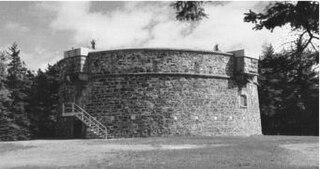
Martello towers, sometimes known simply as Martellos, are small defensive forts that were built across the British Empire during the 19th century, from the time of the French Revolutionary Wars onwards. Most were coastal forts.

Sutton is a residential suburb on the Northside of Dublin, Ireland. It occupies the tombolo which links Howth Head to the mainland, some of the lower slopes of Howth Hill, and a little of the adjacent coasts. The area lies within the jurisdiction of Fingal County Council. There is a small commercial core at the Sutton Cross road intersection.

Howth is an affluent peninsular village and outer suburb of Dublin, Ireland. The district as a whole occupies the greater part of the peninsula of Howth Head, which forms the northern boundary of Dublin Bay, and includes the island of Ireland's Eye, which holds multiple natural protection designations.

Skerries is a coastal town in Fingal, in the north of County Dublin, Ireland. Skerries was historically a fishing port and later a centre of hand embroidery. These industries declined in the early 20th century, however, and it became both a resort town and a commuter town for Dublin City, located approximately 30 km (19 mi) to the south. Offshore from the town are several islands, one of which is a nature reserve, Rockabill.

Sandycove is a suburb of Dublin, Ireland. It is southeast of Dún Laoghaire and Glasthule, and northwest of Dalkey. It is a popular seaside resort and is well known for its bathing place, the Forty Foot, which in the past was reserved for men only but is now available for mixed bathing. The locale features in the opening of Ulysses by James Joyce.
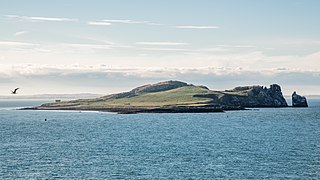
Ireland's Eye Anciently called 'Adros' by Ptolomy, 'Adrea Deserta' by Pliny, and 'Andros' and 'Edria' by other early navigators. is a small long-uninhabited island off the coast of County Dublin, Ireland. Situated directly north of Howth village and harbour, the island is easily reached by regular seasonal tourist boats, which both circumnavigate it and drop off day trippers. There is a yacht anchorage to the north of it, and kayakers also land.

The Howth Tram on the Hill of Howth Tramway was a tram which served Howth Head, near Dublin, Ireland. The termini were at Sutton railway station, by the entrance to the peninsula, and Howth railway station by the village and harbour of Howth.

Howth Castle and estate lie just outside the village of Howth, County Dublin in Ireland, in the administration of Fingal County Council. The castle was the ancestral home of the line of the St Lawrence family that had held the area since the Norman Invasion of 1180, and held the title of Lord of Howth until circa 1425, the Baron Howth to 1767, then Earl of Howth until 1909. The castle and estate are held since 1909 by their distaff heirs, the Gaisford-St Lawrence family.
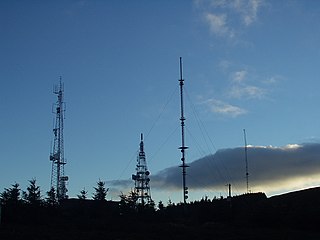
Three Rock Mountain is a mountain in Co Dublin, Ireland. It is 444 metres high and forms part of the group of hills in the Dublin Mountains which comprises Two Rock, Three Rock, Kilmashogue and Tibradden Mountains. The mountain takes its name from the three groups of granite rocks at the summit. It was once believed that these features were man-made: for instance, Gabriel Beranger wrote of them in 1780, "I take them to be altars upon which sacrifices were offered […] the regularity which is observed in piling them convinces me they are the work of man, as they could not grow in that position". In fact, the three outcrops are tors: natural geological features produced by the gradual process of weathering. Today, the summit is dominated by the many radio masts and towers that use the site to broadcast their signals across the Dublin area below. The forestry plantations on the slopes consist mainly of Sitka spruce, Japanese larch, Scots pine, Monterey pine and lodgepole pine.
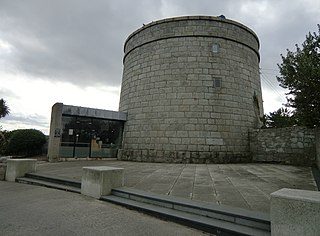
The James Joyce Tower and Museum is a Martello tower in Sandycove, Dublin, where James Joyce spent six nights in 1904. The opening scenes of his 1922 novel Ulysses take place here, and the tower is a place of pilgrimage for Joyce enthusiasts, especially on Bloomsday. Admission is free.

"Hurdy Gurdy Man" is a song by the Scottish singer-songwriter Donovan. It was recorded in April 1968 and released the following month as a single. The song gave its name to the album The Hurdy Gurdy Man, which was released in October of that year in the United States. The single reached number 5 on the Billboard Hot 100 in the U.S. and number 4 on the UK Singles Chart.
Rochdale and Prince of Wales were two troop ships that sank in Dublin Bay in 1807.
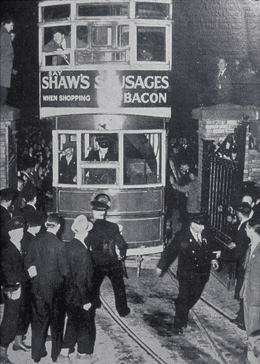
Dublin tramways was a system of trams in Dublin, Ireland, which commenced line-laying in 1871, and began service in 1872, following trials in the mid-1860s. Established by a number of companies, the majority of the system was eventually operated by forms of the Dublin United Tramways Company (DUTC), dominated for many years by William Martin Murphy. Most of the services ran within the city centre and near suburbs, with the majority of major suburbs served. Additionally, there were two longer-range services, one reaching the "excursion" destination of Poulaphouca Falls, and two services concerning Howth.

A Little Bit of Irish is the soundtrack album of music from the 1966 TV special of the same name starring Bing Crosby, which aired on television in the US and the UK on Saint Patrick's Day 1967. The CD was originally issued by Atlantic Records and an expanded version was issued by Golden Olden Records, both in 1993. Songs by the Irish-born composer Victor Herbert were added to the expanded CD, as was a segment featuring Irish tenor John McCormack together with other Irish-themed songs by Crosby from his various radio series.

Sutton Castle or Sutton House is a Victorian Tudor-style castellated mansion house with terraced gardens on the southern coast of Howth Head, overlooking Dublin Bay, in the suburbs of Dublin, Ireland.
29 Martello towers and battery installations were constructed or partially constructed in the Greater Dublin Area between 1803 and 1808. The towers were intended to act as a deterrent against a foreign invasion by Napoleon and his French Armies as well as being used as general lookout posts. In later years, towers were also used as coast guard stations, lookout stations to prevent smuggling and as other general purpose military installations by various British and Irish defence forces.





















